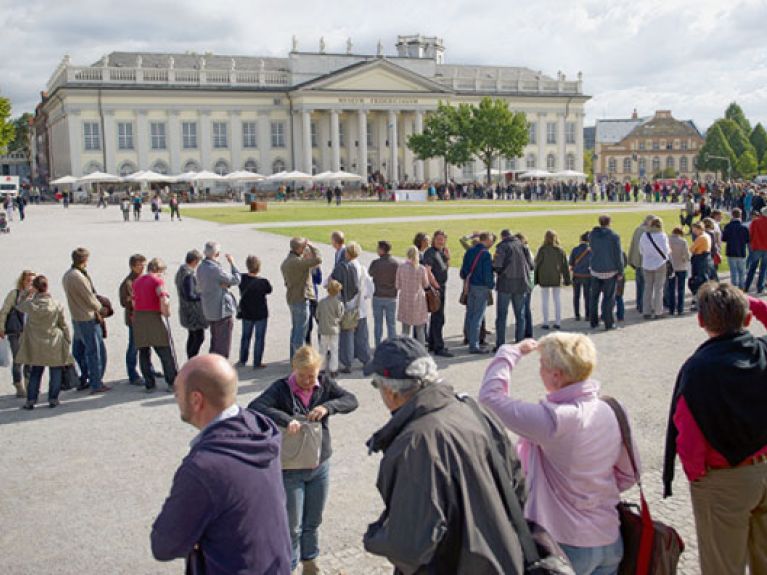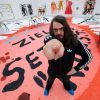Experimental documenta 14
documenta 14 is looming on the horizon. It will be held in 2017 at two equal partner venues: Kassel and Athens.

Learning From Athens. There was widespread surprise when in late 2014 Adam Szymczyk announced the motto of documenta 14 in Kassel, the provincial metropolis two hours’ drive north of Frankfurt am Main. What could the world learn from Athens? How a country drifts to the edge of the precipice? How art and culture deal with the crisis? The sensational decision by the Polish curator – who was previously director of the Kunsthalle Basel for ten years – to open the world’s biggest and most important art show in Athens rather than Kassel in spring 2017 was highly controversial. But Szymczyk‘s “provocation” is not as strange as it may seem. Kassel’s World Heritage Site Schloss Wilhelmshöhe is dominated by the towering copper statue of the Greek demigod Hercules. The landgraves of Hesse-Kassel looked on antiquity as a model for their style of rule. With its portico supported by six Ionic columns, the Fridericianum –documenta’s main venue since 1955 – also harks back architecturally to the Parthenon. In the 19th century, shortly before another state bankruptcy, a German – Prince Otto of Bavaria – was chosen to become the King of Greece. Kassel is 2,500 kilometres from Athens, but the two cities are closer than might be thought.
The city in northern Hesse has been the scene of spectacular art revolutions. In the wake of modernism, it was from here that pop art, action art and political art burst on to the scene after 1968. And it was here that, in the person of Swiss director Harald Szeemann, the curator himself turned into an artist. The 1977 documenta was larger than any exhibition ever held in Germany before. Art lovers still enthuse about Joseph Beuys‘ Honey Pump, Claes Oldenburg’s Mouse Museum and Christo and Jeanne-Claude‘s towering 5,600 Cubicmeter Package. In 2002, Okwui Enwezor used documenta’s 11th edition to address the world‘s post-colonial problem zones close up with discourse “platforms” in Lagos, Vienna, New Delhi, Berlin and St Lucia. His successor, Carolyn Christov-Bakargiev, who caused a stir in 2012 with her idea of non-human forms of art, organised a parallel show to her documenta 13 in a war-damaged palace in Kabul. Collapse and Recovery – Kassel‘s post-war trauma – was, she argued, today most evident in the Afghan capital.
Cultural help for intellectual recovery – that’s also the line now being taken by Adam Szymczyk. He sees Athens as a symbol of the global financial crisis and the crisis of Europe. Like Kassel in 1955, it stands for “the need to deal with the trauma of destruction that was the legacy of National Socialism in Germany”. With his exhibition concept, the curator wants to initiate a learning process between the metropolises in northern Hesse and on the Mediterranean. When he says “The South is a gateway for migration, the North is a fortress”, he is seeking to address Europe‘s biggest problem – and at the same time continue with artistic means the old dispute about whether there is a cultural dividing line bisecting the Old Continent into a rational North and a laissez-faire South. For some, it’s politics; for others, it’s an unexpected chance. “The documenta is an extraordinary opportunity to show that, despite the crisis, culture and creativity are still alive in the city,” explains Athens Mayor Giorgos Kaminis. The Managing Director of documenta, Annette Kulenkampff, emphasises art’s unifying function: “In these difficult times, art could succeed in doing what economics and politics are unable to accomplish: building bridges, overcoming boundaries and breaking down prejudices.”
Turning art and the documenta into a forum for reflection on the current crisis and a bridge of solidarity is an undertaking as risky as it is ambitious. There is likely to be excitement about the concrete form the event’s latest edition will take. The documenta has opened a branch in Athens’ hip neighbourhood Exarchia. The Athens team is headed by Marina Fokidis, director of the Kunsthalle Athena – one of documenta‘s cooperation partners, along with the Athens School of Fine Arts and the Athens Biennale. One thing is certain: around a hundred artists will be participating in documenta 14. All of them are invited to visit both Athens and Kassel and develop a project for each location. But to see the results of what the artists experience there, visitors will have to wait for the two exhibitions to open: on 8 April 2017 in Athens and on 10 June at the Fridericianum in Kassel. Adam Szymczyk intends to make the Athens show “more than a classical exhibition”. Regular scheduled flights between Kassel and Athens will ensure that not only members of the international art scene and those who can afford it get to enjoy the event.
The exhibitions are to go on show for 100 days at each of the venues. And they are expected to trigger a snowball effect. Many institutions in Greece and Germany are gearing their programmes to the “Greek documenta”. So much attention can only benefit the cultural scene in Greece, which has been hit hard by the crisis. And if 2017 were to become a “Greek year” worldwide, documenta 14 would not just be a mark of solidarity. In the end, the whole world would really have learned something from Athens. ▪

